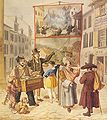Hieronymus Hess
Hieronymus Hess (born April 15, 1799 in Basel ; † June 8, 1850 there ) was a Swiss draftsman and painter during the first half of the 19th century. He is particularly known for his time-critical caricatures and templates for Zizenhausen terracottas .
life and work
Hieronymus Hess came from a petty bourgeois family in Basel with no artistic background. After training as a flat painter, he went to the public drawing school and, until 1817, also apprenticed to the painter Maximilian Neustück . The artist and publisher Peter Birmann commissioned him in 1817 to make copies of the frescoes by Hans Holbein the Younger, which had been rediscovered in Basel's town hall , admired the Hess. Thanks to relationships with his employer and a scholarship, he was able to work and study in Naples and Rome from 1819 to 1823, where he came into contact with Joseph Anton Koch and Bertel Thorvaldsen and the Nazarenes , who had a lasting influence on his style. 1825–1826 followed an engagement in Nuremberg, where Hess met Ludwig Richter , then he settled permanently in Basel and married in 1828. Hess taught as a drawing teacher from 1831–1835. His students included the later sculptor Ferdinand Schlöth , who modeled him full-length in plaster in 1843. As an artist, he produced lithographs based on Hans Holbein's passion tablets, glass paintings, illustrations for the Basler Neujahrsblätter and Martin Disteli's Swiss picture calendar . The important templates for the Zizenhausen terracottas produced by Anton Sohn and sold through the art dealer JR Brenner in Basel were supplied by Hess from 1828–1834. In 1839 he painted the Basler Totentanz in 40 individual pictures on behalf of the publisher Hasler , to which he added 4 new motifs. Among them is the picture The Death to the Painter , in which Hess portrayed himself.
His high-quality, romantically inspired drawings, watercolors, prints and paintings show genre scenes, histories, allegories, portraits and caricatures of political, anti-clerical and social content. In the latter, Hess' disenchantment with the artistically not very open-minded Basel society was reflected. As pictorial documents for the restoration and regeneration period in Basel, his works are of historical significance.
gallery
Juliane von Krüdener in Grenzach , 1817
Art collection in the Haus zur Mücke , 1837
Individual evidence
- ↑ Stefan Hess , Tomas Lochman (ed.): Classical beauty and patriotic heroism. The Basel sculptor Ferdinand Schlöth (1818–1891). Basel 2004, p. 132f.
- ^ Heinrich Sarasin-Koechlin: Hieronymus Hess unknown marginal drawings. In: Bulletin of the Swiss Bibliophile Society, B. 1, Issue 3, 1944, p. 107
literature
- Johann Jakob Im Hof : The history painter Hieronymus Hess von Basel - history of his life and directory of his works. Basel 1887. Digitized version of the Badische Landesbibliothek
- Margarete Pfister-Burkhalter: Hieronymus Hess. 1799-1850. Basel 1952.
- Heinrich Kuhn: Hieronymus Hess, a Basel cartoonist. Basel 1981.
Web links
- Yvonne Boerlin-Brodbeck: Hieronymus Hess. In: Historical Lexicon of Switzerland .
- Paola von Wyss-Giacosa : Hess, Hieronymus. In: Sikart
| personal data | |
|---|---|
| SURNAME | Hess, Hieronymus |
| BRIEF DESCRIPTION | Swiss painter, draftsman and caricaturist |
| DATE OF BIRTH | April 15, 1799 |
| PLACE OF BIRTH | Basel |
| DATE OF DEATH | June 8, 1850 |
| Place of death | Basel |




